Tattoo Ideas 2025

Tattoos in 2025 are blending art, identity, and technology like never before. Here’s what’s trending:
- Micro-Realism: Tiny, highly detailed tattoos resembling photographs. Precision and advanced tools make this possible.
- Neo-Traditional Revival: Classic bold outlines meet modern shading, vibrant colors, and pop culture themes.
- Biometric Fusion: Cybernetic designs mixing human and machine aesthetics, with AR and smart ink elements.
- Eco-Friendly Practices: Vegan and organic inks, biodegradable supplies, and sustainable tattooing methods.
- Hyper-Personalized Tattoos: AI-assisted designs and symbolic systems tailored to individual stories.
- Fluid Dynamics: Abstract, motion-inspired tattoos like watercolor splashes and cosmic swirls.
- Heritage Motifs: Designs inspired by ancient cultures, blending Aztec, Egyptian, and other historical elements.
- UV-Reactive Tattoos: Tattoos that glow under blacklight, perfect for nightlife and festivals.
- Minimalist Architecture: Blueprint-inspired line art showcasing clean geometric designs.
- Nature Themes: Botanical and eco-conscious tattoos reflecting a connection to the natural world.
Tattoos are more personal, innovative, and inclusive than ever, with cutting-edge tools and sustainable practices shaping the industry in 2025.
Tattoo Trends 2025: What's Hot & What's Not!
1. Micro-Realism and Precision Craftsmanship
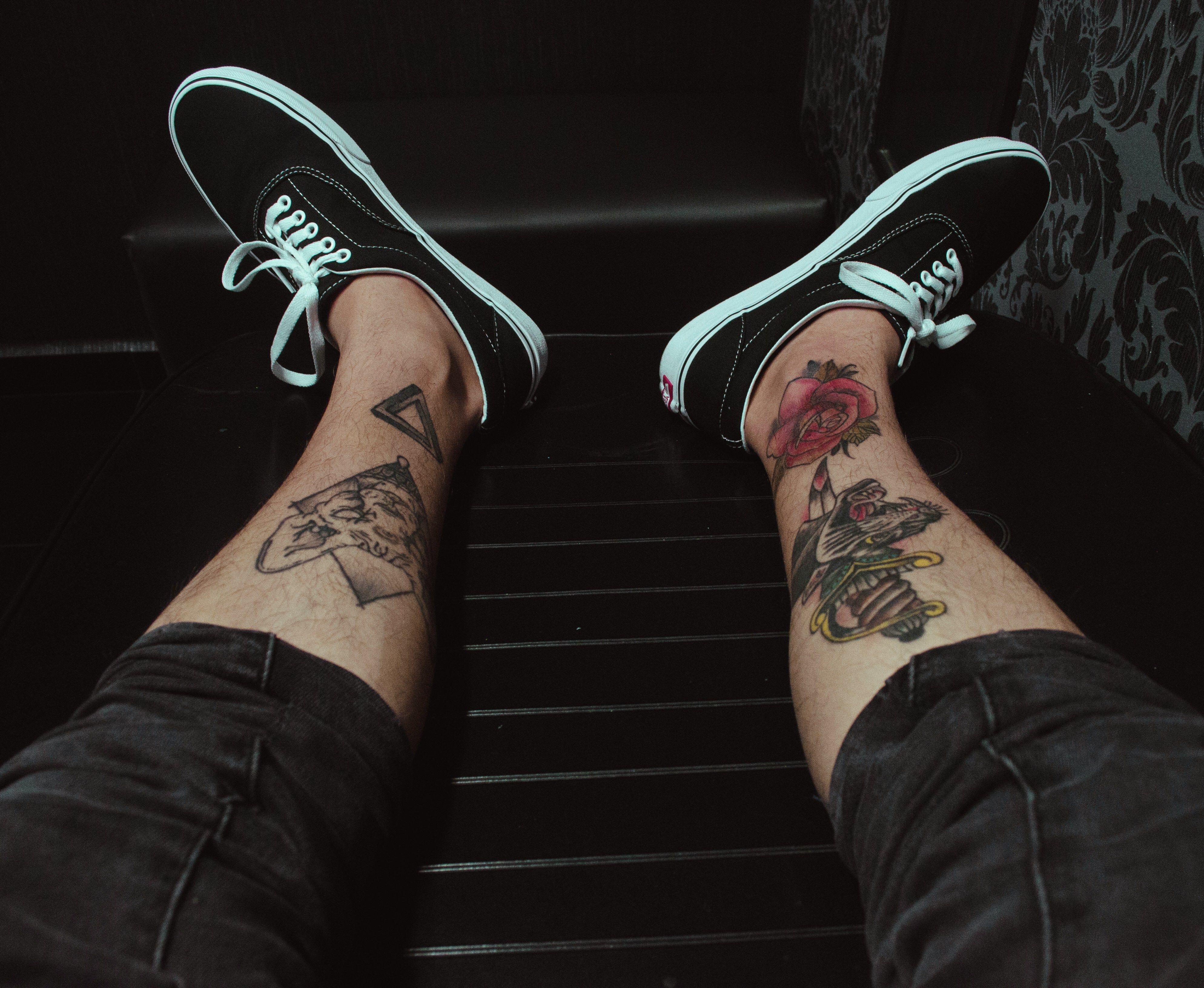
Micro-realism has taken the tattoo world by storm in 2025, standing out as one of the most challenging and visually breathtaking styles. These tattoos pack an incredible amount of photorealistic detail into small spaces, replicating the subtle textures, gradients, and lighting effects you'd expect to see in photographs or real life [7].
At the heart of micro-realism is precision craftsmanship, which requires tattoo artists to possess an extraordinary level of skill. Fine lines lay the groundwork for these intricate designs, while advanced techniques like stippling and whip shading add depth and dimension [7]. For color micro-realism, artists must have a deep understanding of color theory and blending, while black and gray pieces demand flawless contrast control and smooth grayscale transitions [7].
"The phenomenal work we are seeing a lot of from artists in Asia has had a major influence here." - Lynnea, Tattoo Artist at Studio Sashiko [1]
This style lends itself beautifully to a variety of subjects, including portraits of pets and people, architectural designs, and even everyday objects [1]. Drawing inspiration from classical art and photography, micro-realism allows individuals to wear highly detailed art on their skin, making a statement that's both bold and sophisticated [6][7].
The advancements in tattooing equipment have been a game-changer for micro-realism. Thinner needles and refined pigments make it possible to achieve an extraordinary level of detail, with single-needle tattooing becoming a cornerstone of the style. Consistent pressure and expert technique are non-negotiable to ensure sharp lines and avoid mistakes [7][8]. This blend of artistry and technical mastery is setting the stage for even more exciting tattoo trends in 2025.
2. Neo-Traditional Revival with Modern Flair
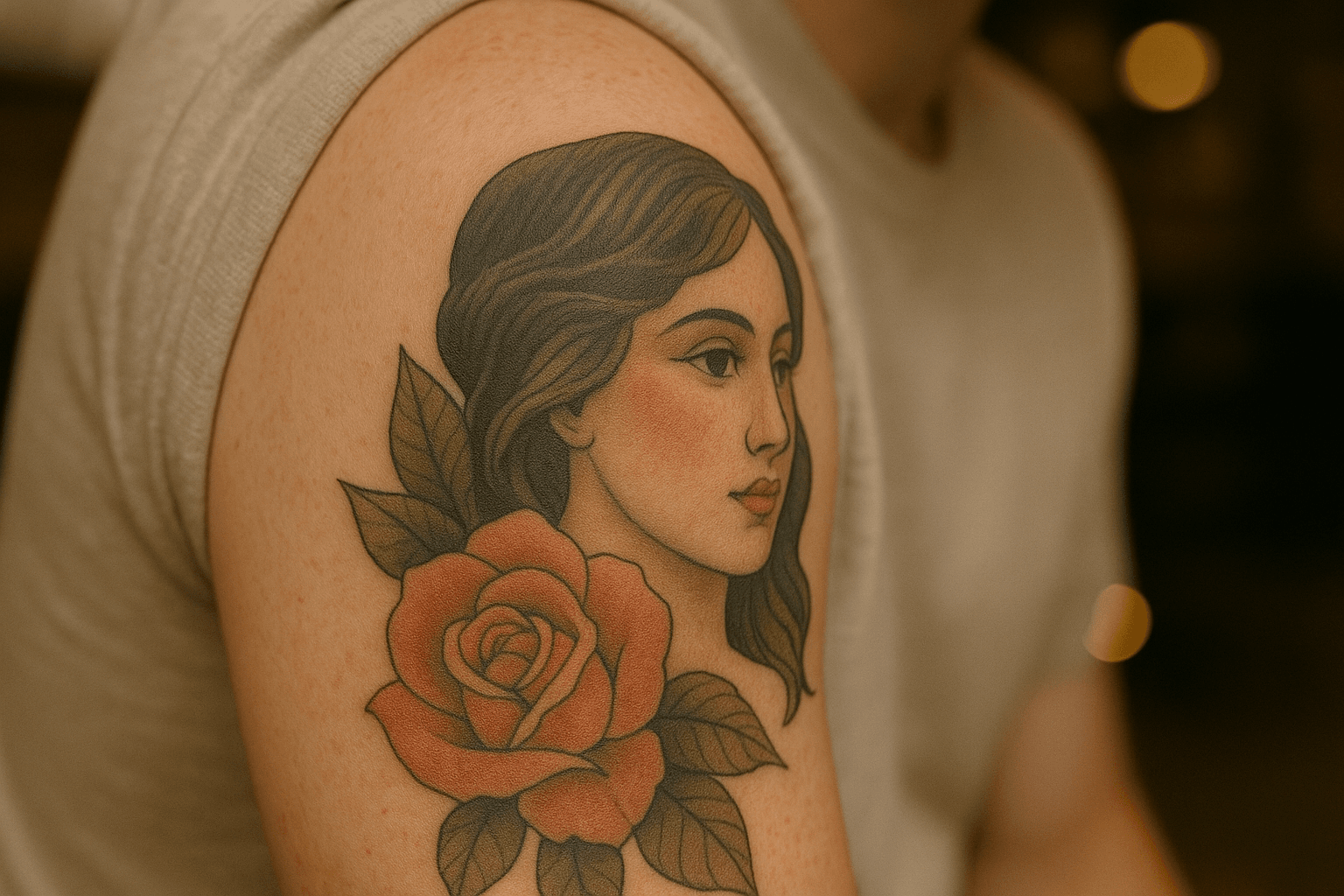
Neo-traditional tattoos are making waves in 2025, blending the boldness of traditional tattooing with fresh, modern techniques. This style keeps the classic thick black outlines that defined old-school tattoos but adds a twist with expanded color choices, intricate shading, and subjects that reflect today’s aesthetics.
"While neo-traditional tattoos still use bold black outlines and classic motifs, they also incorporate detailed elements and fine lines, giving them a modern touch." - Zee, Tattoo artist at Bang Bang Tattoo [1]
One of the most exciting changes is the explosion of color. Gone are the days of sticking to primary hues. Artists now embrace vibrant jewel tones, soft pastels, and smooth gradients, creating a painterly effect that wasn’t possible with older methods. Teal has become a standout highlight color, while muted pastels bring a softer, more contemporary vibe to designs [9]. These advancements mirror the precision seen in micro-realism, pushing the boundaries of what neo-traditional tattoos can achieve.
Modern techniques like 3D shading, varied line weights, and clever use of negative space add depth and dimension, ensuring designs remain clean and visually striking [9].
This revival also pulls inspiration from today’s world. Alongside timeless motifs like roses, daggers, and mythical creatures, artists are weaving in pop culture nods, mental health themes, and even social justice messages [10]. This mix allows people to celebrate tattooing’s rich history while making bold personal statements that connect with current movements.
Bold Color Fusion with Contemporary Themes
One standout trend in this neo-traditional resurgence is the daring use of color. Artists are experimenting with complementary palettes, pairing deep reds with teal highlights or adding neon touches to classic imagery. Animals, portraits, and nautical designs are being reimagined with these bold color choices, giving them a look that feels both timeless and undeniably modern.
3. Biometric Fusion and Cybernetic Aesthetics
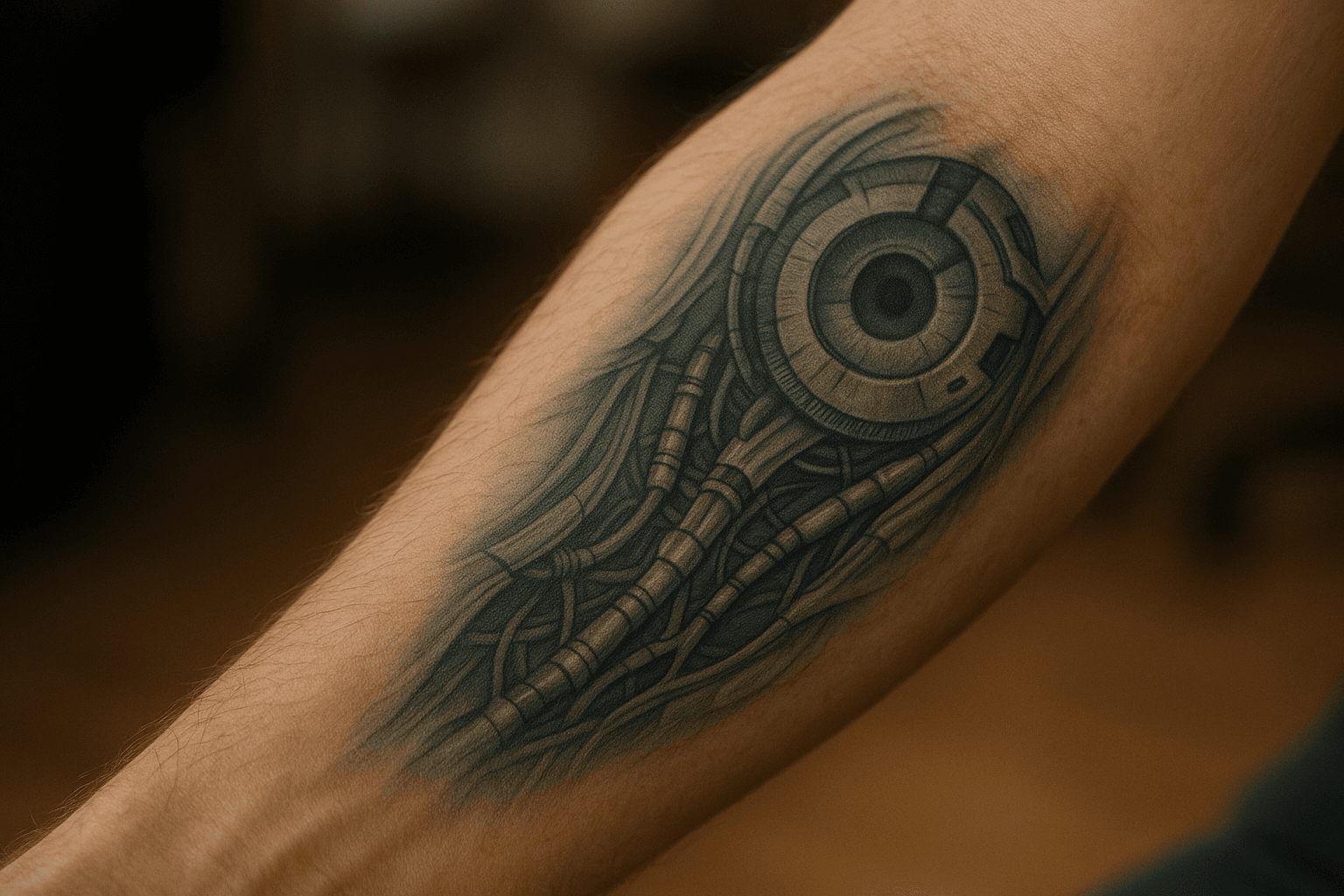
Blending human biology with machine-inspired elements has led to some of the most striking tattoo designs of 2025. These futuristic, cybernetic-themed tattoos blur the line between flesh and technology, reflecting a world where organic and artificial elements increasingly coexist. This artistic approach also highlights a growing trend of using advanced techniques to create deeply personalized body art.
One standout movement in this aesthetic is Cybersigilism. This style brings together intricate, vein-like patterns created with fine lines and grayscale shading. Tattoo artist Annie Motel describes it as a fusion of "ancient spiritual practices with tech-inspired designs", a style that resonates strongly with Gen Z [1]. By weaving spiritual and digital motifs together, this trend achieves a striking balance between the natural and the technological.
The influence of H.R. Giger is unmistakable in this style, which combines Y2K-era tribal designs with biomechanical surrealism. Geometric patterns and mystical symbols are key elements, often executed with thin lines, sharp angles, and spiky details. Black ink and graywash techniques dominate, while abstract shapes and glitch-like patterns give the designs a distinctly modern, tech-inspired feel [1][12][5].
Technology is also playing a major role in pushing these designs into new territory. Augmented reality (AR) overlays allow tattoos to "come alive", adding a dynamic, digital layer to the art. Some tattoos even use smart ink embedded with microchips, enabling interaction with digital devices [13]. Artists are experimenting with LED elements that react to sound or temperature, turning tattoos into interactive experiences [11].
Circuit Board Biomechanics
A fascinating evolution of this trend is the rise of designs that mimic electronic circuitry. These tattoos merge circuit board patterns with anatomical features, creating the illusion of technological components seamlessly integrated beneath the skin. This style not only showcases technical precision but also reinforces the idea of humans and machines becoming one.
4. Sustainable Tattoo Practices and Eco-Inks
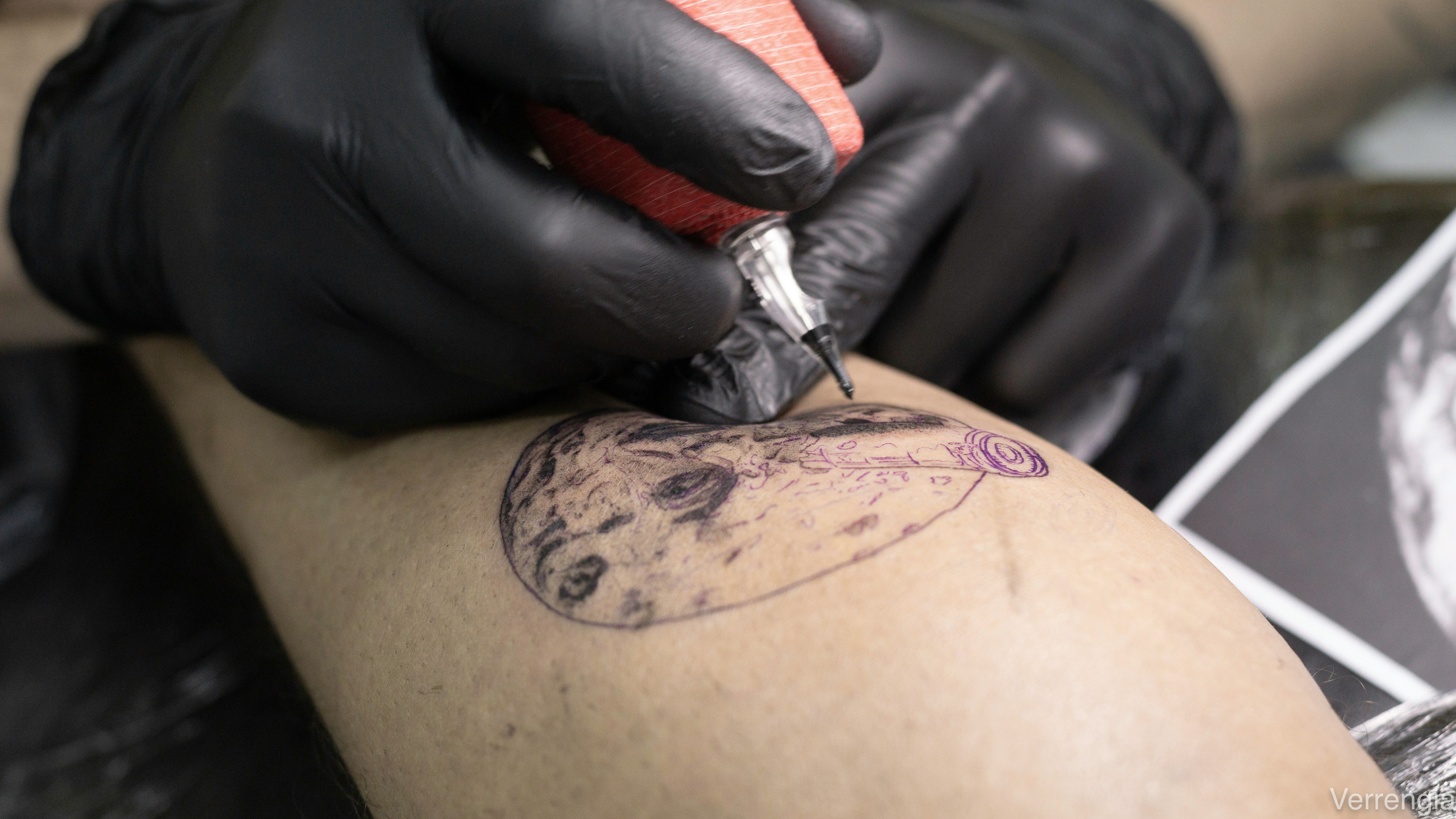
The tattoo industry is undergoing a transformation as environmental awareness reshapes how artists and clients view body art. With the industry's value at $1.78 billion in 2022 and expected to hit $4 billion by 2030 [16], adopting eco-friendly practices has become more than a trend - it's a necessity. This movement shows that creativity and environmental responsibility can go hand in hand.
Today, vegan and organic inks are replacing traditional ones that often contained animal-derived ingredients like bone char, glycerin, and shellac. Instead, these eco-friendly alternatives rely on vegetable-based and mineral-based components, maintaining vibrant colors without harmful chemicals. For example, Quantum Tattoo Ink expanded to the Netherlands in 2022 to meet the growing demand for sustainable options. Vegan inks now commonly use vegetable glycerin, while organic inks incorporate plant-based or mineral ingredients.
"By using high-quality vegan inks, tattoo artists can create stunning designs that maintain their richness and clarity over time." - A Sustainably Simple Life [14]
But sustainability in tattooing doesn't stop with the ink. Studios like Lucy Frost's Greenhouse Tattoo Studio in the UK are setting new standards by adopting eco-conscious practices across the board. From using biodegradable gloves to experimenting with plant-based inks and implementing effective recycling programs, these efforts significantly cut waste while appealing to clients who care about the environment.
"When I started this, there weren't any alternatives for many of the products we use daily. I had three choices: keep doing what I was doing and ignore the environmental impact, quit tattooing altogether, or find a way to make it work sustainably." - Lucy Frost, Founder, Greenhouse Tattoo Studio [16]
Plant-Based Pigment Innovation
One of the most exciting developments in sustainable tattooing is the rise of plant-based pigment systems. By 2025, these systems are expected to deliver vibrant colors derived from renewable sources. These inks meet stringent certifications, including ISO 13485 and CTL certification, ensuring they are both safe and environmentally friendly. Artists should also look for EU REACH compliance and BVL registration, as these certifications guarantee adherence to strict chemical safety standards [18].
Beyond inks, many studios are embracing broader eco-friendly practices. Energy-efficient LED lighting, biodegradable supplies, and improved waste management systems are becoming the norm. These changes reduce energy consumption and waste while maintaining the sterile environment essential for tattooing [15].
5. Hyper-Personalized Symbolic Systems
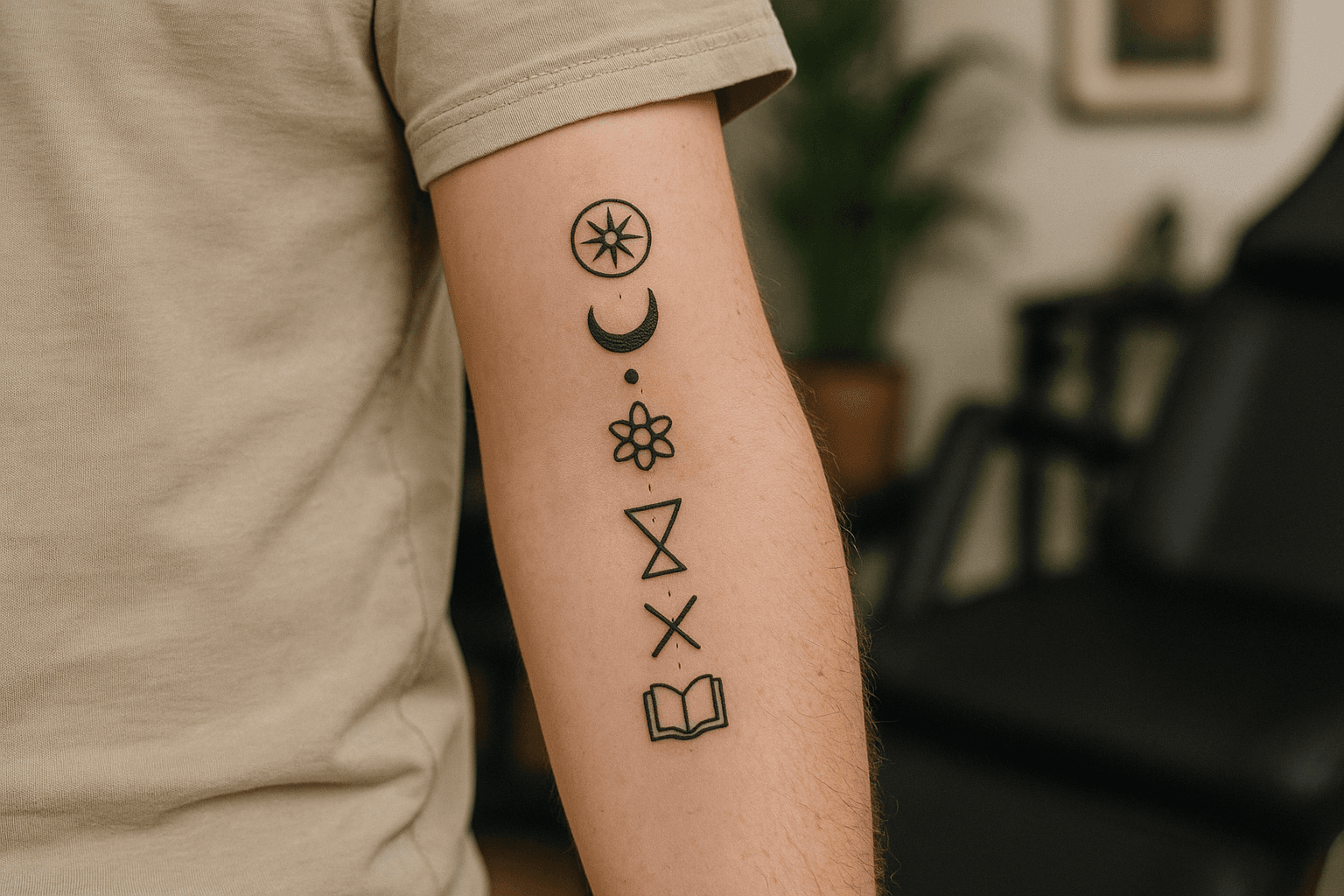
The tattoo world is undergoing a transformation, with hyper-personalized symbolic systems redefining what body art can represent. These designs go far beyond traditional flash tattoos, creating entirely unique visual languages that tell deeply personal stories. It's no longer just about choosing a design from a book - tattoos are becoming intricate narratives, reflecting individual experiences, beliefs, and milestones.
Tattoo artists are now stepping into the role of storytellers, working closely with clients to turn their personal journeys into visual art. This process involves detailed conversations and the use of visual references to ensure the design perfectly captures the intended meaning. It's a thoughtful collaboration where artists balance artistic beauty with the personal significance of each element [20].
To make this process even more dynamic, new AI tools are stepping into the mix. Platforms like Inker AI allow clients to experiment with different styles - whether it's realism, geometric patterns, or something in between - while customizing placement, shading, and size. Other tools, such as TattoosAI, incorporate user feedback through rating systems, and InkStudioAI offers advanced design features compatible with professional software like Procreate and Adobe Illustrator [21].
One standout trend in this movement is the use of layered symbolic designs. Artists are crafting collage-style tattoos that weave together a variety of elements - delicate script, symbols tied to personal milestones, and imagery that reflects an individual's unique journey. These designs are more than just tattoos; they’re visual stories [3].
Custom DNA-Infused Symbolic Tattoos
Taking personalization to an entirely new level, some artists are experimenting with cutting-edge technology, like DNA-infused inks. While still in its infancy, this technique blends identity and innovation, creating tattoos that are not just visually unique but also biologically tied to the wearer [19].
6. Abstract Fluid Dynamics in Body Art
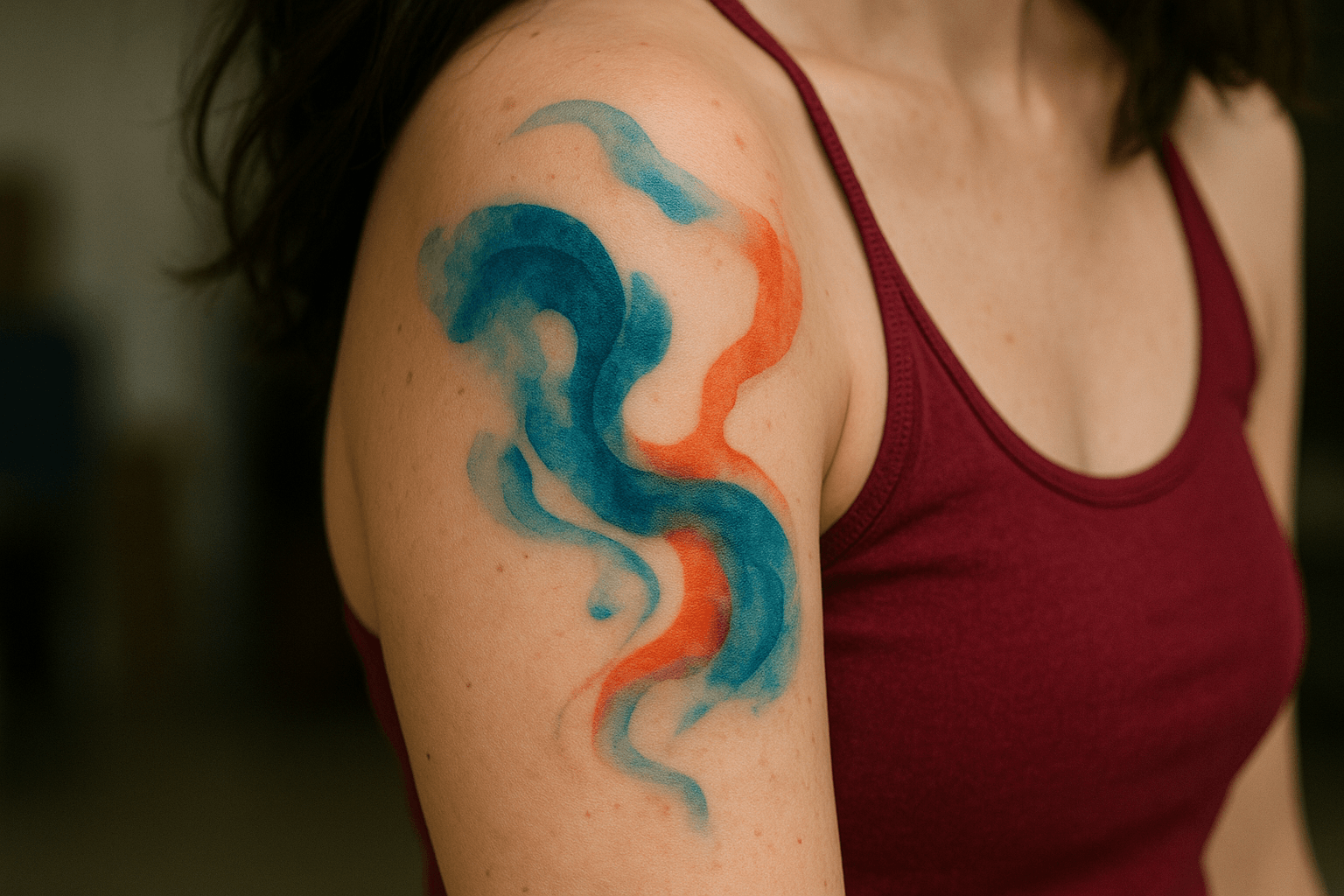
Abstract fluid dynamics tattoos bring a sense of motion to the skin. They combine elements like fluid geometry, cosmic swirls, watercolor-like splashes, and bold brushstrokes to create dynamic, eye-catching designs [22]. Tattoo artists skillfully merge organic shapes with structured geometric patterns, using smooth color transitions and expressive inking techniques that resemble a painter’s brush gliding across a canvas.
To achieve these intricate designs, mastering needle control is critical. This allows for varied line weights and detailed precision. Background elements such as flames, water, smoke, or pre-drawn flow lines are often incorporated to complement the body’s natural contours [24][25]. This balance of technical precision and artistic layering reflects the forward-thinking creativity shaping tattoo trends in 2025.
Suminagashi-Inspired Motion Tattoos
The ancient Japanese art of Suminagashi, where ink is swirled on water to create mesmerizing patterns, has found a new home in tattooing [26]. According to Platinum Ink in December 2024, modern tattoo artists are adapting this "floating ink" technique to skin, crafting abstract designs that evoke the fluidity of ink and water in motion [26].
"Suminagashi tattoos allow individuals to carry a piece of ancient art with personal meaning. Each design is unique, reflecting the wearer's individuality and appreciation for traditional craftsmanship." [26]
Monolith Studio in Brooklyn takes this concept further, creating custom abstract designs that incorporate spirals, wave-like shapes, and asymmetrical negative space. These elements symbolize cycles, transformation, and change [23]. Known for their expertise in fine-line, geometric, and abstract tattooing, Monolith Studio translates emotions and ideas into visually striking body art.
These layered and asymmetrical designs highlight how tattooing continues to blend artistry and innovation in exciting new ways [23].
Streamline Your Tattoo Studio with Tiny Parrot Manage bookings, client communication, and payments effortlessly with our all-in-one tattoo studio software. Simplify your workflow and focus on your art.
7. Archaeological and Heritage Motifs
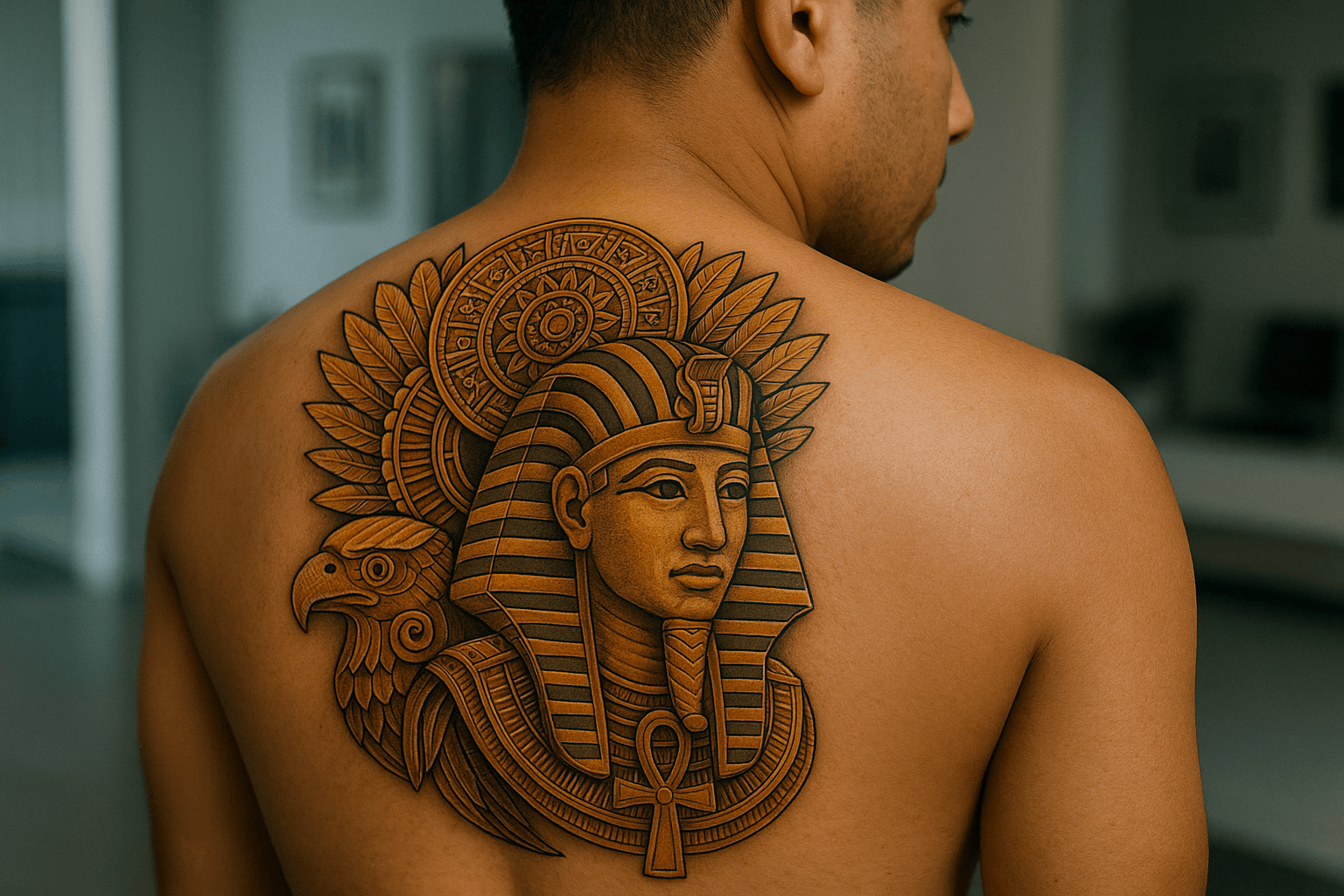
In 2025, tattoos inspired by archaeological and heritage motifs are making a strong comeback. Many tattoo enthusiasts are turning to designs that connect them with ancient civilizations and their cultural roots. These designs carry a profound sense of meaning, often symbolizing strength, resilience, and a spiritual link to the past.
One of the standout trends in this category is the fusion of Aztec and Egyptian designs, which combines the intricate details of these two ancient cultures into bold, symbolic tattoos [27][28]. In Aztec culture, tattoos - known as "tlacuilolli" in Nahuatl - were used to chronicle warriors' achievements, with each design telling a story of valor and conquest. Modern tattoo artists are now blending iconic Aztec imagery, such as suns, eagles, and warriors, with Egyptian elements like pyramids and hieroglyphics. Egyptian pyramids, for instance, are often chosen to represent strength, resilience, and an eternal connection, while Aztec motifs continue to embody the warrior spirit - qualities like bravery, power, and determination that resonate deeply with today’s tattoo enthusiasts [27][28].
However, incorporating heritage motifs comes with a responsibility to honor their origins. Annie Motel, a tattoo artist based in Los Angeles, stresses the importance of respecting cultural contexts:
"When an artist draws influence from traditional, spiritual, or religious symbols - without careful contextualization - cultural appropriation is highly likely." [1]
This resurgence of heritage-inspired tattoos is also driving a rise in neo-traditional styles. These designs combine modern tattooing techniques and vibrant color palettes with the symbolic depth of the original motifs. Artists specializing in this approach collaborate closely with clients to create personalized tattoos that honor the cultural significance of the designs while weaving in individual stories. This thoughtful exploration of heritage motifs not only deepens the connection to ancient traditions but also paves the way for fresh creative directions in tattoo artistry.
8. Luminous and Reactive Ink Technologies
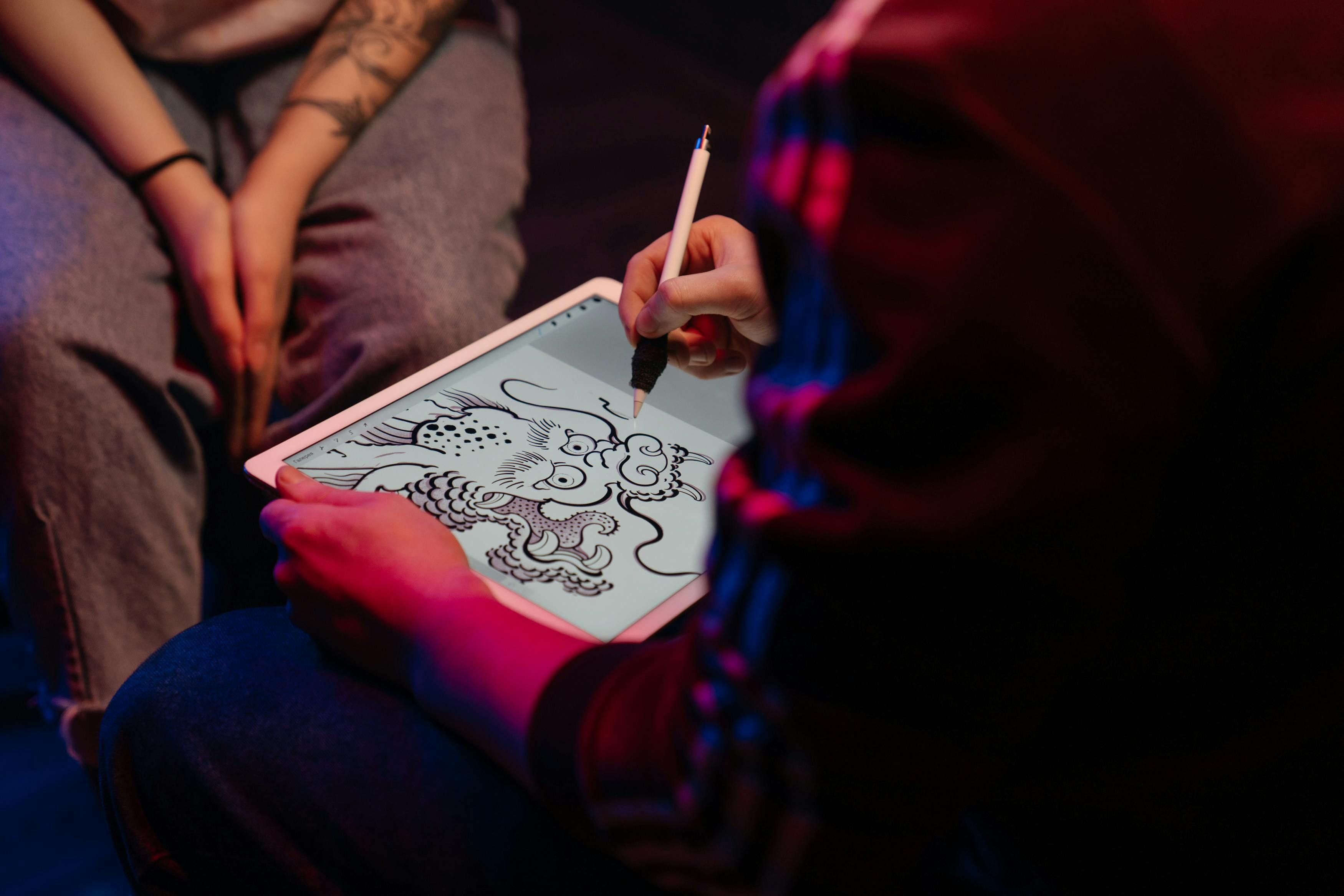
UV-Reactive Tattoos with Dual-Effect Transformations
One of the standout advancements in tattoo technology for 2025 is the rise of dual-effect UV-reactive tattoos. These designs combine traditional and UV-sensitive inks, creating tattoos that transform under blacklight. This cutting-edge approach is redefining tattoo artistry, offering a blend of creativity and innovation.
Modern UV tattoos rely on phosphorescent materials that absorb UV light and emit it as visible light, producing a glowing effect. Unlike the early versions from the 1990s, which often had inconsistencies, today’s UV inks are far more reliable. They’re also vegan-friendly and hypoallergenic, addressing concerns about safety and inclusivity. On average, these tattoos maintain their vivid appearance for 1 to 5 years, depending on care and exposure [30][32].
What makes these tattoos especially appealing is their element of surprise. They look like regular tattoos in daylight but reveal hidden designs, change colors, or glow brilliantly in UV-lit environments like clubs, concerts, and festivals. This makes them particularly popular among nightlife enthusiasts and festival-goers [29]. For tattoo artists, this trend requires precision and an understanding of how to create designs that seamlessly shift between their daytime and UV-lit appearances.
In December 2024, Tattoounleashed.com highlighted the growing popularity of UV tattoos, especially among festival attendees. The platform also emphasized the importance of using high-quality UV-reactive inks and educating clients about proper aftercare to maintain the tattoo's brightness [4].
However, working with UV inks comes with its own set of challenges. These inks are thinner than traditional ones, so artists must take extra care during application to avoid damaging the skin. Protective gear like gloves, face masks, and eye protection is essential to ensure sterility and safety during the process [31][32].
Clients also need to be cautious. A patch test is highly recommended since UV inks carry a higher risk of adverse reactions. Aftercare is equally critical - regular moisturizing, avoiding excessive sun exposure, and using sunscreen can help preserve the ink’s reactive properties [32][33].
This fusion of art and science continues to push the boundaries of what tattoos can achieve, making UV-reactive designs a fascinating choice for those seeking something truly distinct.
9. Minimalist Architectural Tattoos
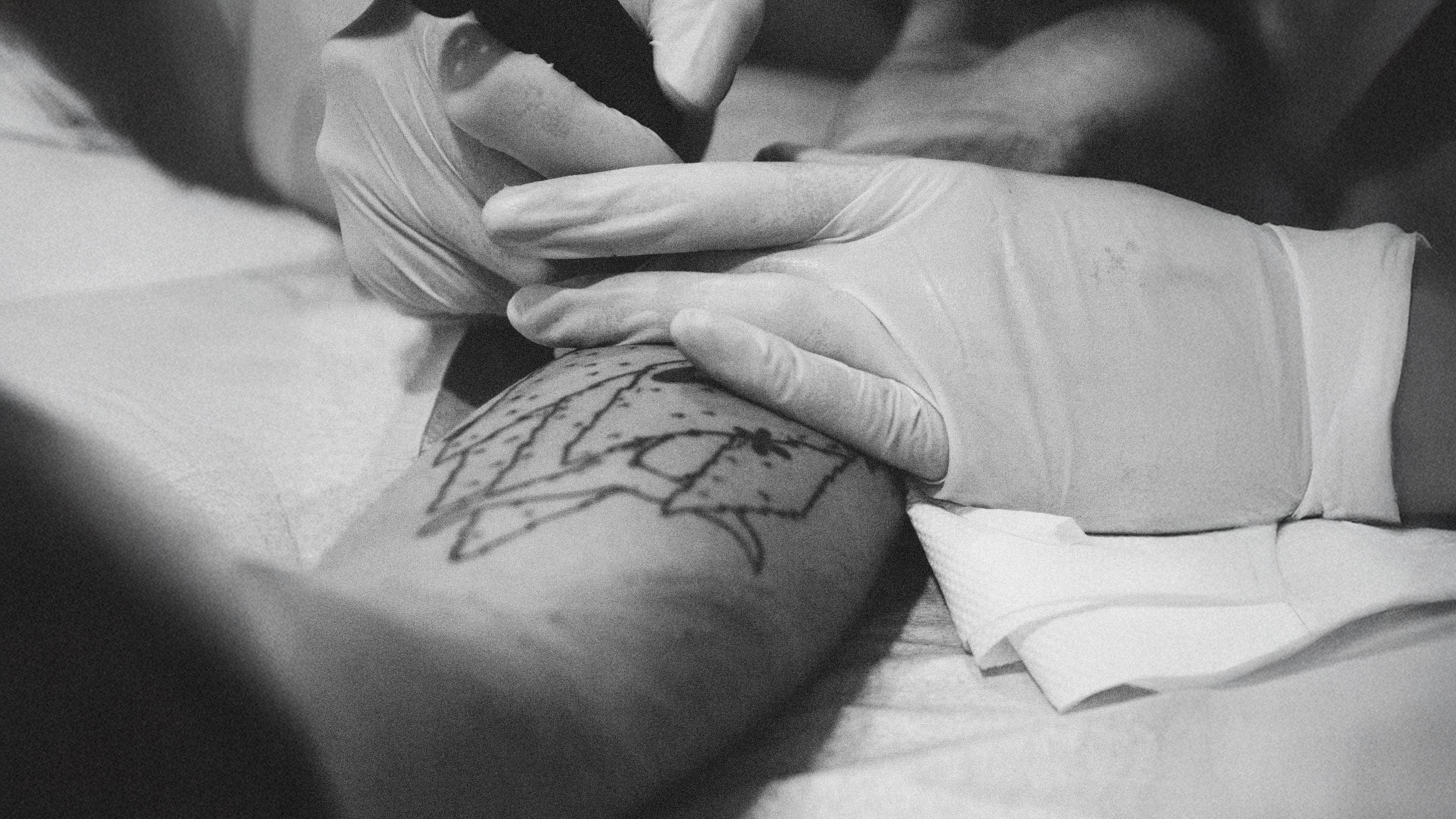
Blueprint-Inspired Line Art with Geometric Precision
Minimalist architectural tattoos are a sleek and modern way to showcase an appreciation for design. These tattoos focus on simplicity, relying on clean lines and geometric shapes to convey architectural concepts. They embrace the essence of modern design by stripping away unnecessary details and letting the art speak through its clarity and precision [36].
What makes these tattoos stand out is their clever use of negative space combined with meticulous linework. By mimicking the look of architectural blueprints, these designs create a sense of structure and balance that feels both refined and artistic. The absence of filler allows the focus to remain on the intricate details, making them perfect for those seeking a subtle yet meaningful form of expression [36][34].
Common choices for these tattoos include iconic buildings like the Eiffel Tower or the Sagrada Família, reimagined through minimalist line art [36]. Geometric patterns inspired by architectural blueprints are also a favorite, featuring sharp angles, symmetry, and distinct patterns that result in visually compelling designs [35].
These tattoos bring architectural principles to life on skin through their use of clean lines, simple forms, limited color palettes, and carefully chosen placement [35]. They offer a timeless style that resonates with anyone drawn to the elegance of modern design.
10. Nature-Inspired and Eco-Conscious Themes
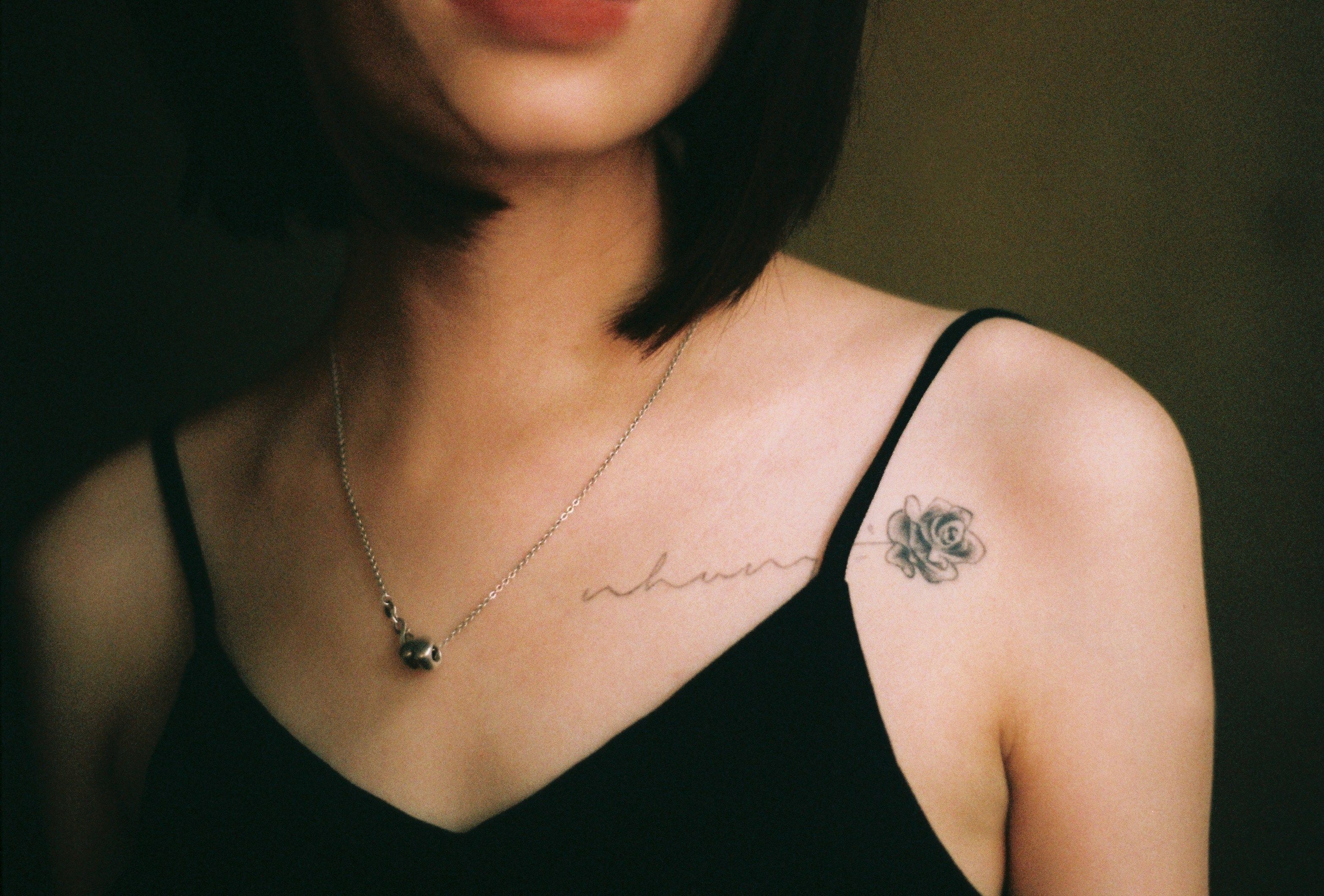
Delicate Botanical Tattoos and Eco-Friendly Practices
In 2025, tattoos inspired by nature are taking the spotlight, showcasing intricate linework that brings ferns, wildflowers, and floral arrangements to life. These designs beautifully reflect the essence of the natural world [37].
But it’s not just about the art - there’s a growing movement toward sustainability in tattooing. Many studios are now using biodegradable and vegan inks, which steer clear of animal-derived ingredients and harmful chemicals. This shift aligns with the values of clients who care deeply about the environment [17].
Artists like Lucy Frost are leading the charge in eco-conscious tattooing. Her studio has implemented recycling programs and found ways to minimize waste, all while maintaining the same high standards of artistry [16].
The designs themselves often pull inspiration from the natural world - think leaves, flowers, and vines symbolizing growth, renewal, and a deep connection to the earth. Some even include endangered species or native wildflowers, blending artistry with a message of conservation and biodiversity [2]. These tattoos often embrace a fluid, organic style, creating deeply personal expressions of one's bond with nature [38].
This trend represents more than just a love for natural beauty. It reflects a broader commitment to sustainability, with both artists and clients working together to make the tattoo industry greener.
Conclusion
From the rise of micro-realism to the adoption of eco-conscious inks, 2025 is shaping up to be a transformative year for the tattoo industry. These emerging trends are not just changing the way artists create and studios operate - they’re also redefining the client experience and reshaping the business side of body art.
Digital platforms continue to dominate the market, with tattoo-related content racking up an impressive 73.6 million views on social media [39]. This growing demand for hyper-personalized designs is pushing studios to adopt AI-powered design tools. These tools don’t replace the artist’s creativity; instead, they speed up the design process, enabling artists to develop custom concepts in days rather than weeks [42].
The shift toward digital tools doesn't end with design. Mobile optimization has become a must-have for studios, as more than half of all web traffic comes from smartphones [41]. Studios that fail to adapt their booking systems and online portfolios for mobile users risk losing potential clients before they even step through the door.
Collaboration is also redefining the creative process. Gone are the days when clients simply picked designs from flash sheets. Today, clients bring personal stories and symbolic ideas to consultations, resulting in more meaningful tattoos and higher satisfaction rates. These longer, more in-depth consultations highlight the growing trend of co-creating designs between artists and clients.
For artists willing to embrace these changes, the opportunities are endless. Studios adopting eco-friendly practices are attracting clients who value sustainability, while those integrating technology - like augmented reality consultations and QR code tattoos - are setting themselves apart as leaders in the field.
The financial rewards are just as striking. Top-tier artists now charge anywhere from $300 to over $1,000 per hour for specialized work, and multi-session projects can cost anywhere between $1,500 and $5,000 or more [40]. This shows how innovation and expertise are driving the industry to new economic heights.
Success in 2025 will require a mix of adaptability and artistic integrity. Artists who combine traditional techniques with modern tools are striking a balance between respecting tattoo heritage and exploring new creative possibilities [43]. Whether it’s the precision of micro-realism or the appeal of sustainable practices, the year ahead promises countless opportunities for artistic growth and business innovation.
With innovation and collaboration leading the way, tattoo artistry in 2025 is all about pushing boundaries while staying deeply personal. It’s a future where technology, creativity, and individuality come together to redefine what’s possible.
FAQs
How are eco-friendly practices and vegan inks shaping the tattoo industry in 2025?
In 2025, the tattoo industry is embracing a greener path by implementing eco-friendly practices and introducing vegan inks. These vegan inks steer clear of animal-derived ingredients and harsh chemicals, providing a safer, cruelty-free choice for both tattoo enthusiasts and artists. Beyond being a more ethical option, these inks help lessen the environmental footprint of tattooing, making them a popular choice for those prioritizing sustainability.
Tattoo studios are also making changes by adopting biodegradable supplies, cutting down on waste, and using energy-efficient systems. This shift highlights a growing dedication to environmental care, paving the way for a more sustainable tattooing future while resonating with clients who value eco-conscious practices.
What are the essential techniques and challenges of creating micro-realism tattoos?
Creating micro-realism tattoos demands a high level of precision and expertise. Artists achieve these incredibly detailed designs by using ultra-fine needles, premium-quality ink, and meticulous shading techniques to bring lifelike images to life on a small scale. Techniques such as dotwork and soft gradient shading are often employed to add depth and enhance the realistic effect of these tiny masterpieces.
However, working with such a limited canvas presents unique challenges. It’s tricky to include intricate details without making the design feel cluttered. Another concern is longevity - micro-realism tattoos can fade or lose their clarity over time, especially if the execution isn’t flawless. Ensuring proper skin preparation, precise technique, and diligent aftercare is essential to help these tattoos age gracefully while preserving their fine details.
How are augmented reality and smart ink changing the future of tattoos?
Augmented Reality and Smart Ink: The Future of Tattoos
Tattoos are no longer just static designs inked onto the skin - they’re evolving into something far more dynamic and interactive, thanks to augmented reality (AR) and smart ink.
AR tattoos add a whole new dimension to body art. When viewed through AR apps or glasses, these tattoos can come alive with animations, sounds, or other digital effects. Imagine a simple tattoo that transforms into a moving image or tells a story when scanned - it's like carrying a little piece of interactive art wherever you go. This blend of technology and creativity allows wearers to express themselves in entirely new ways, making their tattoos as unique as their personal experiences.
Smart ink takes things a step further by embedding technology directly into the tattoo itself. These advanced inks can include sensors or microchips that interact with your body or surroundings. For instance, some tattoos might change color to indicate hydration levels or even monitor glucose levels for people with diabetes. This fusion of art and functionality turns tattoos into more than just a form of self-expression - they become tools that can provide real-time health insights.
With these innovations, tattoos are breaking boundaries, becoming both a form of storytelling and a practical extension of the body. It’s an exciting time for body art enthusiasts looking to combine creativity and cutting-edge technology.
Streamline Your Tattoo Studio with Tiny Parrot Manage bookings, client communication, and payments effortlessly with our all-in-one tattoo studio software. Simplify your workflow and focus on your art.


